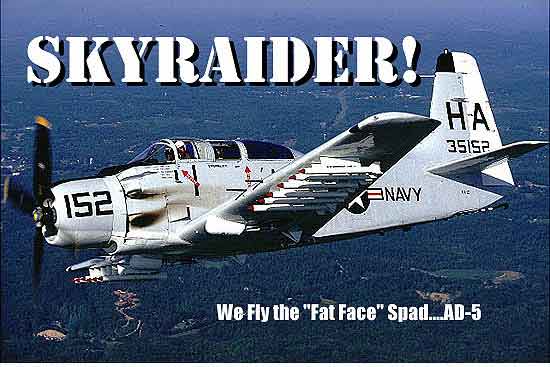 |
AD-5 Skyraider: Dipping
into the Horsepower Pool |
PAGE FIVE All Navy airplanes have great slow speed characteristics and I was curious about the Skyraider's. The power came back and I set it up for a clean stall, not expecting even remotely what I got. Here we were, weighing half of what a small town weighs, but the airspeed kept winding down until at about 90 knots, the stick started tickling me. Then, as the speed kept going down, the airframe was buffeting harder until, just before the stall broke, it was hammering my brains out. Talk about stall warning! You'd have to be asleep to miss it. Gear and flaps down, the final stall was down around 70-75 knots, with a slight break and left roll, but the buffet was still just as pronounced. I held it deep into the stall, then, all it took was releasing back pressure for it to start flying again. Cessna's don't stall any better than this! In fact, they don't give that much warning.

Dropping the nose to head back to the field, I was again brought up short: Nose down, it doesn't want to pick up speed anything like I expected. In fact, I had to really crank the nose down trim into it to hold it down long enough to touch even 200 knots. With the speed brakes out and full ordnance, pilots doing the real thing must have been able to come in at terrific angles and still make the pull out. We were using 100 knots as a target speed in the pattern on downwind, which surprisingly enough, the airplane was perfectly willing to decelerate to by just reducing the power. I didn't have to yank it into a bank or do anything drastic to get it slow. My intent was to hold 1,000 feet and 100 knots. We'd been cruising around at altitude at about 28 inches of manifold pressure. It was taking less than 20 inches to hold 100 knots. Then I threw the gear and flaps out and everything changed. The throttle went up. And up. And then up some more until I was back at 28 inches. This thing is dirty! Doc ran through the pre-landing check list, told me he wanted 90 knots over the fence and to slowly de-accelerate all the way down to that number. At the time I thought, yeah right! Just slowly de-accelerate and hold glide slope. I wasn't half way through base leg when I realized I wasn't even beginning to work to hold speed. If I wanted 95 knots, it would sit at 95 knots. If I wanted 92 knots, that's what it would hold. The power was gradually coming back, as I worked my way down final trying to keep the runway numbers stationary in the windscreen. If they were moving up, I was going to be short. Moving down, I'd be long. At the bottom end of the throttle travel, it turned out there was really very little movement required to change glide slope. It was more of a pressure and the perceived engine noise hardly changed at all. A little high. Pressure the throttle back. Coming back on glide slope, pressure it forward. Just follow the runway numbers with the throttle. Then the runway was right there and the game was over. I was going to have to land this thing! This would be the heaviest tailwheel airplane I'd ever landed. I sneaked a quick peak at the windsock. I shouldn't have and didn't need to to know the wind was there. I was already one wing down and holding opposite rudder to keep the nose aligned with the centerline. In situations like that, it's just going to be what it's going to be. Deal with it. Cardinal rules of landing tailwheel airplanes: Keep the nose in front of you: keep the airplane from drifting: hold three point attitude. If you do all of those, gravity has a way of solving everything else. As I started to break the glide, I slowly began squeezing the throttle closed. I was talking to my right hand on the stick. I was telling it to get into three point just as the runway came up. There the attitude is! Hold it off, hold it! Oops, slight rudder needed. Keep it straight. Hold it off, hold it...thunk! We touched down. On all three yet! And with no bounce! Something about even a blind pig finding an acorn once in a while fits here. Okay, I was down. Keep it straight. Eyes fixated on the centerline. Feet connected to the eyes. A little left rudder. A little right. Brakes. More Brakes. We coast to a halt. Alright! Cheated death one more time! As I tried to decide which taxiway turnoff to take, an Aztec pilot behind me on short final said, "How about it Skyraider. You going to clear the runway anytime soon?" One smart comment deserves another. I said, "That was my first Skyraider landing. Gimme a break. How was your first one?"
I made a handful more takeoffs and landings, but none were as good, or as sweet, as that first one. The first time is always the sweetest. As I became more and more comfortable with the airplane, I came to realize what a relative pussy cat the Skyraider was, when compared to so many other airplanes of its type. It was superlative in its handling and control feel and, aside from a demonstrated willingness to turn into the wind, if you'd let it (I did once), it did whatever you asked of it. No wonder its pilots loved it so much.
|